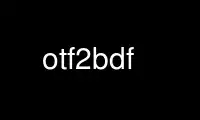
This is the command otf2bdf that can be run in the OnWorks free hosting provider using one of our multiple free online workstations such as Ubuntu Online, Fedora Online, Windows online emulator or MAC OS online emulator
PROGRAM:
NAME
otf2bdf - OpenType to BDF font converter
SYNOPSIS
otf2bdf [options] font.{ttf,otf}
DESCRIPTION
otf2bdf will convert an OpenType font to a BDF font using the Freetype2 renderer
(http://www.freetype.org).
OPTIONS
otf2bdf accepts the following command line arguments:
-v print warning messages when the font is converted.
-n disable glyph hinting.
-p n set the desired point size (see default value by running the program with the -h
option).
-et display a list of the platforms and encodings available in the font. The default
values, compiled into the program, are a platform of 3 (Microsoft) and encoding of
1 (ISO10646). If the font does not contain the default platform and encoding, the
fallback will be the Apple ISO10646 encoding.
-r n set both the horizontal and the vertical resolution (see default value by running
the program with the -h option). The minimum is 10dpi and the maximum is 1200dpi.
-rh n set the horizontal resolution (see default value by running the program with the
-h option). The minimum is 10dpi and the maximum is 1200dpi.
-rv n set the vertical resolution (see default value by running the program with the -h
option). The minimum is 10dpi and the maximum is 1200dpi.
-o outfile
sets the output filename (default output is to stdout).
-pid id set the platform id for selecting the character map (see default value by running
the program with the -h option).
-eid id set the encoding id for selecting the character map (see default value by running
the program with the -h option).
-c c set the character spacing. This should be one of `P' for proportional, `M' for
monospace, or `C' for character cell. By default, the spacing of a font will be
automatically determined to be either `M' or `P' according to values provided in
the font.
-f name set the foundry name used in the XLFD name. The default value is `Freetype'.
-t name set the typeface name used in the XLFD name. By default, otf2bdf will attempt to
get a name from the font first and then it will use the name supplied with this
command line option, and if all else fails, it will use the name `Unknown'.
-w name set the weight name used in the XLFD name. If this value is not supplied, the
default value is assumed to be `Medium'. Some common values for this are `Thin',
`Delicate', `ExtraLight', `Light', `Normal', `Medium', `SemiCondensed',
`Condensed', `SemiBold', `Bold', `Heavy', `ExtraBold', and `ExtraHeavy'.
-s name set the slant name used in the XLFD name. If this value is not supplied, the
default value is assumed to be `R', for Roman. Some common values for this are
`R' for Roman, `I' for Italic, `O' for Oblique, `RI' for Reverse Italic, and `RO'
for Reverse Oblique.
-k name set the width name used in the XLFD name. The default is `Normal'.
-d name set the additional style name used in the XLFD name. The default is an empty
string.
-u char set the character used to replace the dashes/spaces in a font name. The default
is the space character.
-l subset
define a list of character codes which will be used to select a subset of glyphs
from the font. The syntax of the subset string is the same as the syntax for
selecting subsets in X11 XLFD font names. Example:
% otf2bdf -l '60 70 80_90' font.ttf -o font.bdf
The command above will only generate the glyphs for codes 60, 70, and 80 through
90 inclusive. Glyphs that are not in the subset are not generated.
-m mapfile
specifies a mapping file which will reencode the BDF font when it is generated.
Any glyphs with codes that do not have a mapping will not be generated.
The remapping file should begin with two lines, one which starts with REGISTRY
followed by the character set registry and one which starts with ENCODING followed
by the encoding. An example from the iso8859.2 file:
REGISTRY ISO8859
ENCODING 2
The remapping data should be two columns of hexadecimal numbers, separated by
spaces or tabs. The first column should have the code which should be used in the
BDF font. The second column should be the hexadecimal code of the glyph in the
"cmap" table otf2bdf is using. An example mapping file is provided which will map
fonts from Unicode (the default "cmap" table) to ISO8859-2.
Unicode is not the only option. If you choose another platform and encoding ID on
the command line, then the remapping is assumed to map from the chosen platform
and encoding to some other character set.
Use otf2bdf online using onworks.net services
